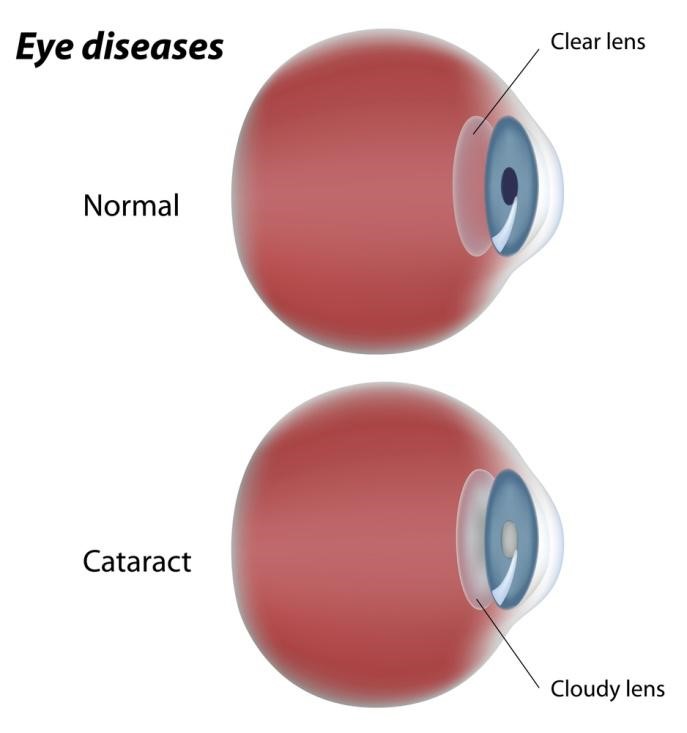More than half of all people in the U.S. over the age of 65 develop cataracts. As such, they are some of the most common causes of vision problems in the world. Fortunately, advancements in laser eye technology have made cataracts more treatable now than ever before.
Cataracts are a product of the aging process. Over time, proteins in the eye buildup and the lens begins to cloud over, preventing light from fully passing through it and into the retina. This does not allow the retina to properly focus, impairing and distorting vision. In addition to age, there are other environmental and genetic factors that contribute to the development of cataracts, including: frequent exposure to sunlight, certain medications, smoking, and injuries to the eye.
The location of the cataract on the lens greatly affects vision loss. There are three types of cataracts, each affecting vision in its own way:
1. Nuclear cataracts: Form on the central area of lens and affect distance vision. Up-close vision, however, remains relatively unchanged.
2. Cortical cataracts: Develop on the sides of lens and affect peripheral vision, leaving distance and up-close vision intact. May not ever be noticeable or greatly impair vision, and thus may not ever require surgery.
3. Posterior subcapsular cataracts: Form on the back of the lens, affecting up-close vision needed for reading, sewing, and other detailed activities. Also often associated with glare.
Because cataracts develop slowly over time, some of their earliest symptoms often go unnoticed for many years. Early symptoms of cataracts include: difficulty seeing at night, light sensitivity or glares, “halos” around lights, a yellow or brown tint to your vision, and frequent changes in prescription strength.
As an age-related condition, cataracts will continue to worsen over time. If untreated, they can cause mild to complete vision loss. Although many people live with cataracts for years without needing surgery to correct their vision, this is not true for everyone. Fortunately, more treatment options are available now than ever before, making clear vision into old age a possibility for everyone.
The Laser Procedure
Femtosecond assisted cataract procedures, like the bladeless HD cataract surgery performed here at OCLI, are some of the safest and most popular treatments for cataracts. During this procedure, a femtosecond laser is used to make a microscopic incision in the outer layers of the eye.
Classified as an ultrashort pulse laser,femtosecond lasers operate at one-quadrillionth of a second. As a result, they are able to cut the eye’s outer layers at the molecular level, enabling surgeons to make incredibly precise and accurate incisions while doing minimal damage to the surrounding tissue.
After cutting the outer layers of the eye, your eye surgeon will insert a needle-sized probe into the incision. The probe emits ultrasound waves, emulsifying the lens. The lens fragments are removed and a new synthetic intraocular lens (IOL) is then inserted. Although early IOLs did not adjust to changes in light and focus, modern IOLs such as the Crystalens® allow the lens to move and adjust accordingly, providing patients with greatly improved vision at all distances. This significantly decreases the patient’s need for glasses or contacts later in life.
After the Cataract Surgery
Some patients may notice significant improvements to their vision immediately after the surgery. For others, it may take a few hours for their vision to stabilize. Many patients have reported wavy, blurry, or cloudy vision and bloodshot eyes following the procedure. These symptoms usually clear up within an hour or two post-op. However, if they persist, talk to your eye doctor about them at your follow-up appointment as it could be a sign of a more serious complication.
As with any invasive medical procedure, cataract surgery has its risks. However, with a success rate of nearly 98%, cataract surgery is one of the safest and most common elective procedures performed in the United States. Infection, bleeding, and retinal detachments are possible complications from cataract surgery, though they only occur in a small percentage of patients.
Because cataract surgery is an outpatient procedure, much of the post-op care in the days following the procedure is the patient’s responsibility. In order to minimize your risk of complication and facilitate your recovery, it is important to follow your eye doctor’s instructions for at-home care. Unlike LASIK, patients who undergo cataract surgery are not required to leave wearing a protective shield, although many ophthalmologists recommend that they wear sunglasses. Additionally, patients may be instructed to wear an eye patch or a protective shield at night and during naps.
If your cataracts are impairing your vision and making it difficult to perform day-to-day activities, consult your eye care specialist at OCLI for more information.

